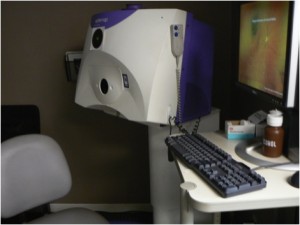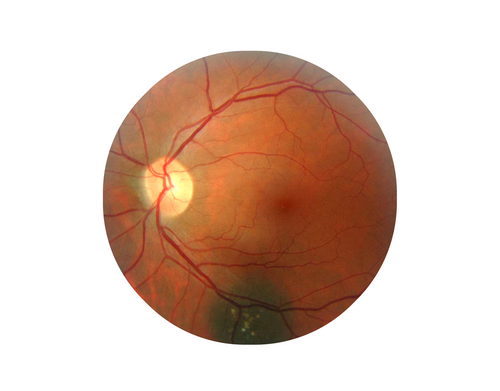Diagnostics

Computerized Visual Field Analysis
Visual field testing is an important clinical function, which after your complete eye examination Dr. Hadden or his Associate may recommend for you. This further examination will test the peripheral vision of your eye. The examination is performed with the assistance of a technician with an automated machine and is called an automated perimetry examination. In this type of test you look at a central spot while lights of different intensities are projected inside a large bowl. If and when you see the light you will indicate that by pushing a button. Analysis of the data will allow the optometrist to construct a map of the visual response of the retina and other neurological tissues. This will enable the optometrist to make certain determinations about the health of the eye and neurological system. It is particularly important in detecting glaucoma and monitoring the treatment of the disease. Glaucoma is nicknamed the “thief of sight” and is a disease in which peripheral vision is lost. Early detection of this disease is very important, as you may not even be aware of its presence until you have your annual eye examination.
Field-testing on the Humphrey Field Analyzer is fast and easy. It contains a microprocessor to record test data and provide a visual field map. By using a field analyzer the optometrist is able to screen for various diseases, which are often difficult to detect. Perimetry testing is also important in the screening, diagnosing, and monitoring of various eye, retinal, optic nerve and brain disorders. Extensive diagnostic analysis is also possible so that the extent of any problems can be determined and measured. The modern perimeter also has computer storage capability so that the effectiveness of medical treatment can be determined at each of your visits.
Opto map Retinal Scans and Dilated Fundus Exams
 Dr. Hadden and his associates, look through your pupil to examine a layer of tissue that covers the back and inside walls of your eye. Traditional viewing methods can be effective, but difficult to perform and are carried out manually and without digital record. Dilation drops facilitates the retinal examination. The optomap ultra wide digital retinal imaging system captures more than 80% of your retina in one panoramic image. Traditional methods typically reveal only 20% of your retina at one time. This enhanced view helps our optometrists detect even the earliest sign of disease that presents on your retina.
Dr. Hadden and his associates, look through your pupil to examine a layer of tissue that covers the back and inside walls of your eye. Traditional viewing methods can be effective, but difficult to perform and are carried out manually and without digital record. Dilation drops facilitates the retinal examination. The optomap ultra wide digital retinal imaging system captures more than 80% of your retina in one panoramic image. Traditional methods typically reveal only 20% of your retina at one time. This enhanced view helps our optometrists detect even the earliest sign of disease that presents on your retina.
The optomap takes just minutes to perform; it is fast and painless for patients. It is particularly helpful when you return for your annual exam as it provides a permanent digital record of the condition of your retina. Dr. Hadden and his associates will compare each year’s optomap image side by side to discover even subtle changes and monitor your continuing eye health. Early detection of retinal disorders is critical to preventing serious progression and loss of vision.
Your retina is the only place in the body where blood vessels can be seen directly. This means that in addition to eye conditions, signs of other diseases such as stroke, heart disease, high blood pressure and diabetes can also be seen in the retina.
This is a photo of a CHOROIDAL NEVUS (Freckle) in the retina. This is a condition that is monitored regularly to rule out malignancy
Pachymetry
Corneal pachymetry is the process of measuring the thickness of the cornea. It is particularly essential prior to a LASIK procedure for ensuring sufficient corneal thickness to prevent abnormal bulging out of the cornea, a side effect known as ectasia. The instrument used for this purpose is known as a pachymeter.
Corneal pachymetry is also considered an important test in the early detection of glaucoma. In 2002, the five-year report of the Ocular Hypertension Study (OHTS) was released. The study reported that corneal thickness as measured by corneal pachymetry was an accurate predictor of glaucoma development when combined with standard measurements of intraocular pressure. As a result of this study and others that followed, corneal pachymetry is now used by some optometrists to better diagnose and detect early cases. Dr. Hadden and his Associates are pleased to be able to offer this service to their patients.
Perceptional Testing
This test relates to children’s learning and their ability to read. Visual perception is defined as the ability of the eye to take in information and interpret it. It is not just seeing, but translating visual images into information that the brain can remember, organize, recognize and use. It allows children to understand what an image means, such as shape and letter recognition.
Visual perceptual problems can impact many areas of academic performance in children. In reading, children may experience difficulty in recognizing letters that are similar or words that they have seen before. Spelling can be impacted with visual perceptual problems, as children often reverse letters and numbers. Interpreting math symbols, charts, maps, graphs and diagrams can also be difficult. Lastly, handwriting and left/right discrimination for fine motor and gross motor activities can also be affected by visual perceptual problems.
Visual perceptual problems can be assessed by an optometrist. Several standardized tests exist that measure visual perceptual skills, such as The Test of Visual Perceptual Skills (TVPS), the Developmental Test of Visual Integration (VMI), Motor-Free Visual Perceptual Test (MVPT). In this respect, Dr. Hadden is a qualified optometrist who can conduct the MVP Test and who will subsequently help with visual perceptual problems through his recommended vision therapy. Dr.Hadden will set up a customized program of regular eye exercises and activities which are aimed at remediating processing and interpreting of visual information. Some examples of activities that can improve visual perceptual skills include mazes, dot to dots, puzzles, hidden pictures and copying shapes and objects.
Dr. Hadden has extensive experience working with children, as for many years he was the sole optometrist for the extremely high needs children at the Chrisptopher Robin Home for Children in Ajax.
Heidelberg Retinal Tomograph
The Heidelberg Retinal Tomograph also known as the HRT is a machine that is used for the assessment of the optic nerve and is extremely helpful for the diagnosis and monitoring of glaucoma. Using a special scanning laser that creates a three dimensional map of the inner surface of the eye, the HRT detects very fine structural changes to the optic nerve and nerve fibre layer that can occur with glaucoma damage long before patients notice any changes in their vision. The benefit of the HRT to the glaucoma patient is an earlier diagnosis and more sensitive disease monitoring, with necessary treatment provided to help prevent vision loss. The HRT provides Dr. Hadden and his Associates with more information about your eyes than has ever been available before, and gives them a significant advantage in helping to preserve your vision.
HRT testing is an option available for patients who would like the latest and best technology to help preserve their vision. Glaucoma is diagnosed and monitored using three main criteria: the pressure inside the eye, peripheral vision tests; and optic nerve examination. However, the optic nerve examination is the most critical step in the diagnosis and monitoring of glaucoma. Therefore, the benefits of the HRT are tremendous in an early diagnosis.
